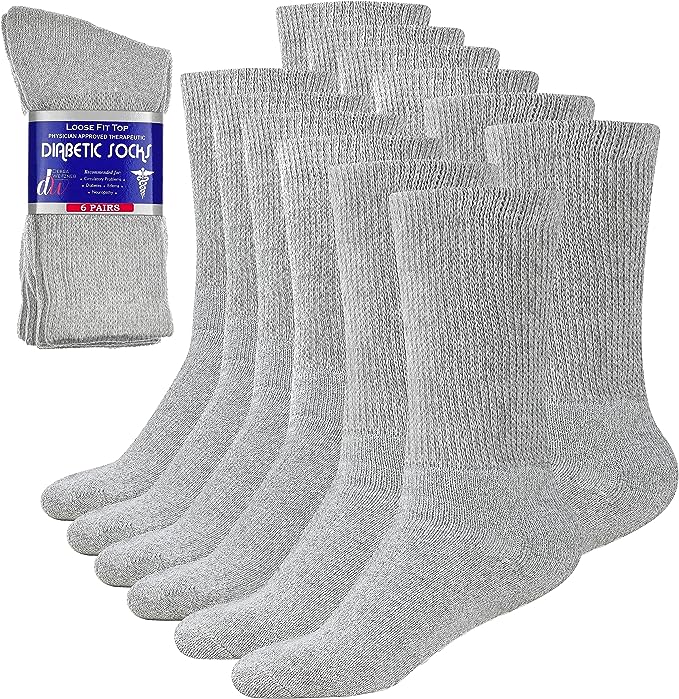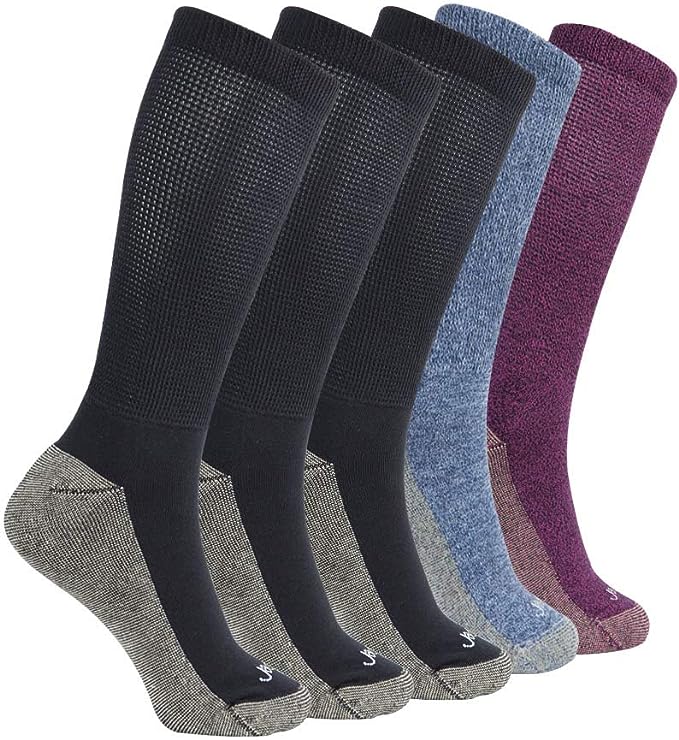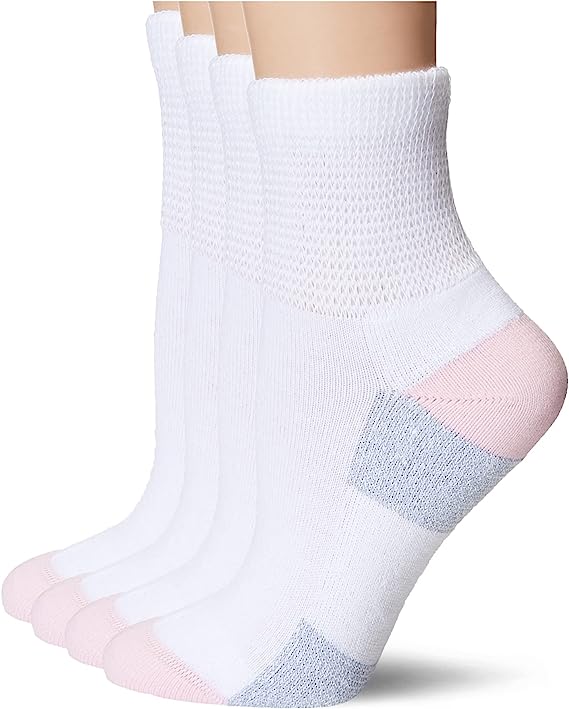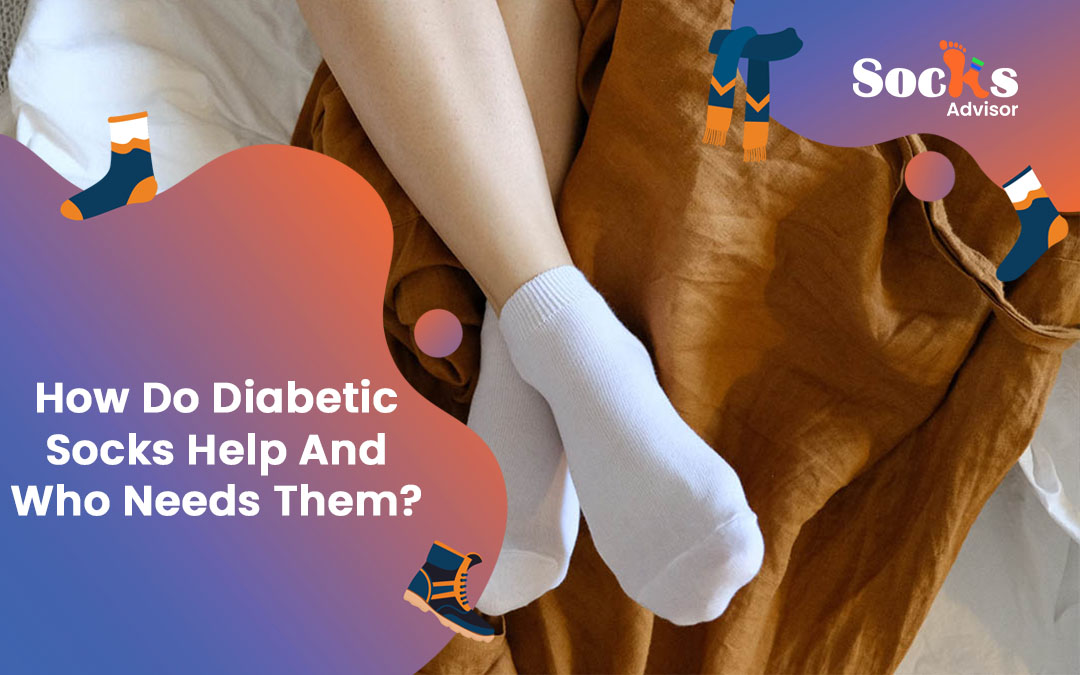Diabetic socks help and here’s how!
The thought of having diabetic socks might sound flavorless to some while to some it may excite them to jump off from their seats. Just like I did when I got to know that something like this also exists on this earth.
However, you gotta be careful before making that jump of joy. Because sudden elevation of Dopamine (the happiness hormone) is good but by any condition, if you lend your foot to a pointed object, it will demote your pleasure to pain.
Ever wondered about what is the root cause of stress for diabetic patients? It’s a failure of getting sensations. You will have bloodstreams running out of your body and yet you would feel nothing. But wait what’s the connection of zero sensations with the socks? And how do diabetic socks help in this regard?
Keep reading to know its answer because the focal idea here is to inform.
What are diabetic socks?
“Diabetic socks are the special type of socks designed for people with diabetes”. They are great at keeping the feet dry through features like moisture-wicking. Swelling reduction by being seamless, and blisters and bruises protection via providing cushioning to the feet.
These socks are the best to call fleeting happiness. And all their power moves are in their acrylic or synthetic fiber material. With these socks on you can free yourself from the hectic daily foot examination.
Diabetes in today’s world may sound like a common disease to live with and day-to-day variations in its treatment are also adding relief to the patients’ lives. From the introduction of insulin drips to the induction of insulin pipes and finally, the new insulin stickers, we have seen it all. However, it all can go in vain because of a single ignorance, especially with the term “diabetic neuropathy”.
Best Diabetic Socks on Amazon

Debra Weitzner Diabetic Socks
- 90% Cotton, 7% Elastane, and 3% Polyester
- Machine Wash
- Breathable, soft, and well-fitting
- Physician-approved
- Highly recommended for people with diabetes, edema, and neuropathy
Diabetes effect on feet:
Diabetic patients mostly face two kinds of foot problems.
- Sensory Diabetic neuropathy– Highlights the failure of the body’s sensory neurons to alert you about cold, heat, or pain in the areas. Especially arms and legs due to uncontrolled glucose levels in the blood that ultimately lead to nerve damage.
- Peripheral Vascular neuropathy– It’s the condition of delayed healing of sores and cuts due to improper blood circulation. This can also lead to serious issues like gangrene- A term used for tissue death due to lack of blood.
These two are the reasons why people with diabetes do not feel pain on encountering anything that can make them bleed. While on the other hand, the delayed healing response from the body can lead to cutting off the toe, leg, and even death. Now you might have got an idea of why are diabetic socks a great invention.
Top 10 Benefits of Diabetic Socks:
- Improves blood circulation by being non-binding and non-constricting.
- Allows long hours of walks due to its inbuilt seamless technology
- Provides thermoregulation by equal distribution throughout the socks
- Breathable material leaves no space for fungal and bacterial accumulation.
- Heel and toe reinforcement to protect against tearing off of the material in the key pressure points
- Moisture-wicking capability by letting the damp molecules evaporate outside the material.
- Inline cushioning and padding add comfort at the walk and provide protection from bruises
- The white or lighter sole color of the sock alerts the owner of blood flows
- Pull-on closure features allow the socks to be stretched to desired positions without putting pressure
- Minimize the risk of future amputations by supporting the wound healing process.
How do diabetic socks help?
Diabetic socks have been designed in a way to alleviate pressure on the foot and leg. Which is normally caused due to restricted blood flow that occurs due to unbalancing of glucose levels. Such restricted blood flow can easily lead to damage of the nerves and ultimately foot ulcers delayed wound healing and tissue death in the corresponding area.
Let’s see how you can cope with this problem with the diabetic socks features.
1. No top binding:
The root cause of all diabetic severities is restricted blood circulation in the arms and legs. Wearing socks that have a higher compression ratio at this stage can worsen the problem. This is why you need something that is restrictive. Because you definitely won’t be ready for the socks to slip off your feet again and again and non-binding to allow the proper blood circulation.
Proper blood circulation will also help wound healing due to the proper flow of immune cells. Such as keratinocytes (immune cells responsible for wound healing) and dermal cells such as platelets and fibroblasts to the site of injury and will initiate their process of healing.
Diabetic socks are both restrictive and non-binding. This is why they stick to your legs and yet free you from getting any kind of compression lines. It also keeps the foot warm due to the proper flow of oxygen around the area.
2. Moisture-wicking fabric:
Best moisture-wicking diabetic socks

JAVIE Copper Crew Socks for Men & Women
- 76% Combed cotton, 12% Copper, 10% Nylon, 2% Spandex
- Machine Wash
- Non-binding top
- Moisture wicking fabric
- Seamless toe designed
- Ultra soft
- Cushioned
Nothing can be worse and more annoying than the occurrence of infection in an injured area. Yet diabetic patients go through this situation often. Ordinary socks keep your feet dry and if you wear them for a long time, the moisture starts to develop. Especially in the toe area. Such a damp environment provides perfect habitat formation opportunities for fungi and bacteria. And they are quick to cause severe foot allergies, sock tan, and ulcers.
But with diabetic socks, you will not go from this situation of non-imaginable pain. The material of diabetic socks evaporates the moisture molecules outside the fabric. Rather than inoculating them inside and this is how they keep your feet dry.
However, there is a potential difference in the moisture-wicking capability of each fabric. But the manufacturers of today have smartly made combinations of fabric in each sock to demote this problem. And let you experience the comfort of moisture-wicking at its best. The most common fabrics used are acrylics, cotton, spandex, nylon, and natural and synthetic fibers.
3. Cushioning and Padding :
I personally love this feature of diabetic socks and I want it in each and every sock I wear. Diabetic socks come with inline soft cushioning and extra padding, especially in the key areas where there is a high risk of getting bruises and cuts such as heels and toes.
Cushioning features make these socks really soft and comfortable to wear. The interesting part here is that its sole is mostly built-in white or light color fabric so in case you get an injury, you can at least see the blood. However, You won’t see cuts or bruises coming your way once you wear diabetic socks.
The cushions and pads are thick and strong and won’t tear off easily. Shock and impact resistance is another element that these socks protect you from by showing an instant reaction to absorbing it rather than letting it make its way to your foot.
4. Zero seamless technology:
Best Seamless Diabetic socks

MediPEDS Women’s Diabetic Quarter Socks
- 56% Acrylic, 28% Nylon, 15% Polyester, 1% Lycra Spandex
- Imported
- Pull On closure
- Machine Wash
- Non-binding top
- Soft cushioning
- Seamless toe
You can also start your long walk practices by having these on which doctors usually recommend to diabetic patients to overcome weight loss issues. The walk is also good to regulate blood circulation and warmth distribution around the body. These socks are lighter in weight and practically seamless. They push you to walk longer without feeling any weight or pressure on your foot.
The seam is also beneficial at restricting rubbing and irritation and its material is made wrinkles free. Wearing ordinary socks when you have blisters or bruises on your foot can worsen the wound and cause irritation however diabetic socks don’t let your feet be in direct contact with the material and leave space for breathing and evaporation.
5. Diabetic Socks Material
Diabetic socks are available in a variety of materials such as cotton, wool, acrylic, synthetic fiber, and Spandex. However, the recommended ones are acrylic and synthetic fibers because the acrylic material is the lightest, most impact-resistant, UV reflector, and a great thermal insulator while synthetic fiber has a prominent role in socks’ durability, stretching, softness, stain, and water resistance.
Now you know why the manufacturer decided to go with both of them. You might find them in combination like 66% acrylic and 46% synthetic fiber or as independent material.
6. Odor Resistance
Odor resistance however does not have any clear connection with diabetes but is still an annoying aspect that we all go through in our daily lives. Diabetic socks are built with copper and silver material that leaves no room for odor.
7. Diabetic Socks Varieties
Diabetic socks vary in material, properties, leg length, and colors.
Material variations include
- Cotton blend with stretch tops
- Non-cotton blend with antimicrobial properties
- Compression diabetic socks
- Plain non-binding socks
- Fiber Fabric built socks
Note that these variations are constant and might vary due to day-to-day quality improvement and feature enhancement.
Size Variation:
Diabetic socks can be found in different leg lengths and sizes such as heel length, over-the-toe length, till knee-length, extra-large sizes, and normal standard sock length as well.
Color Variation:
Color variation in diabetic socks is usually rare because they have been purposely kept as white to make the blood flow visible if by any condition you get exposed to cuts. However, it can be available in other lighter colors in which the blood diffusion is visible.
Frequently Asked Questions:
Who needs Diabetic Socks?
As per its description, diabetic socks are mainly designed for people suffering from diabetes to protect their feet from swelling, blisters, bruises, cuts, and heavy feels on their feet while walking however they can also be worn by normal people for various reasons because there is no hard and fast wearing rule to it. The only difference that possibly exists would be between need and desire.
Note: We are not pushing all diabetic patients to buy these socks however there is no lie in those who buy them, are benefitted.
Diabetic patients with severe foot allergies, ulcers, and injuries are highly recommended to spend some pennies on these socks.
How do diabetic socks help non-diabetic people?
Features like inline cushioning, odor resistance, moisture-wicking, and seamless, reinforcement are ideal sock features that anyone can opt to go with. It can also help them with preventing future infections and treatment of the current ones.
Girls who wear heels generally feel pressure in the toe. Wearing these socks can turn out as a relief for them.
What is the difference between diabetic socks and compression socks?
Compression socks are designed to add pressure on your legs to increase blood flow. They also help to maintain the blood levels to decrease discomfort and swelling while diabetic socks also maintain blood levels but they do not add pressure but rather alleviate the pressure on the focal points.
Where can I get diabetic socks?
Diabetic socks are available both online and offline in a number of variations.
How do diabetic socks benefit pregnant women?
Gestational diabetes is common in some pregnant women. This condition can lead to deep vein thrombosis or DVT. It is a condition where blood clots are formed due to non-maintained glucose levels and this can ultimately lead to miscarriage or abnormal baby development.
Wearing diabetic socks can help these women with regulating blood sugar levels.
What are the diabetic foot symptoms?
The common diabetic foot symptoms are
- Change in skin color of the feet usually yellowing of the feet
- Temperature regulation in the feet
- Sudden swelling in the legs
- Ingrown fungal toenails
- Cracked heels and toes
- The feeling of itching and dryness
Final words
Thank you for bearing my words till the end!
We are now in a position with a handsome knowledge of how do diabetic socks help and whether they are worth buying or not. For me, diabetic socks are great day-to-day wear. It lets me be at ease at long walks, my weight has been possibly reduced and my foot health is also considered good.
It’s always recommended to contact a podiatrist before trying anything new.




